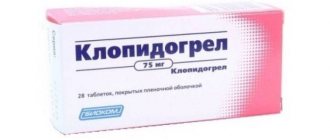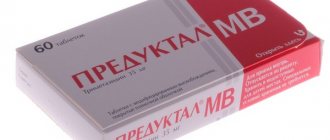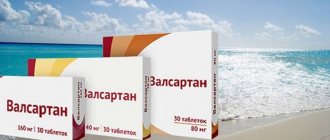Compound
1 tablet of Rimecor contains 20 mg of trimetazidine , the active ingredient.
Minor ingredients: ludipress, magnesium stearate, aerosil, lactose, croscarmellose sodium. Shell: polyethylene glycol 4000, titanium dioxide, hydroxypropyl methylcellulose, talc, acid red. 1 tablet of Rimecor MB contains 35 mg of trimetazidine , the active ingredient. Minor Ingredients: Methyl methacrylate copolymer, mannitol, microcrystalline cellulose, montan wax, ethyl acrylate, trimethylammonioethyl methacrylate chloride, magnesium stearate. Shell: polyvinyl alcohol, titanium dioxide, polyethylene glycol, talc, aluminum varnish (yellow, blue, Ponceau 4R).
Pharmacodynamics and pharmacokinetics
Rimecor is a drug that, under conditions of ischemia , improves metabolic processes in neurosensory organs and myocardium . Directly affecting brain neurons and cardiomyocytes , it leads to optimization of their function and metabolism .
Cytoprotective effectiveness is due to an increase in energy resources , stimulation of oxidative decarboxylation and increased oxygen consumption , by blocking the oxidative processes of fatty acids and improving aerobic glycolysis .
Trimetazidine has a beneficial effect on myocardial contractility and prevents a decrease in the level of phosphocreatine and ATP inside cells. In case of acidosis it normalizes the functioning of membrane ion channels prevents the accumulation of sodium and calcium in cardiomyocytes , and helps to normalize the content of potassium ions in cells. Reduces the amount of phosphate and intracellular acidosis observed during myocardial ischemia and reperfusion.
Resists the damaging effects of free radicals, protects membrane cell walls inhibits the activation of neutrophils in the area of ischemia , lengthens the electrical potential time, limits the release of CPK from cells and reduces the severity of myocardial .
Reduces the number of attacks during angina pectoris , while helping to reduce the intake of nitrates . Over the course of 14 days after administration, there is an increase in the patient’s tolerance to physical activity, as well as a decrease in the incidence of blood pressure changes .
During therapy with Rimecor, patients experience improvement in their hearing and vestibular system , and the sensation of tinnitus and dizziness . Taking the drug for eye pathologies of vascular origin leads to the restoration of retinal functionality.
When taken orally, most trimetazidine is rapidly absorbed from the gastrointestinal tract, achieving a bioavailability of 90%. Plasma Cmax, when taking 20 mg trimetazidine , is observed after 2 hours and is equal to 55 ng/ml (when taking MB tablets after 3-5 hours and remains at a level of at least 75% for 24 hours). It binds to plasma proteins by 16%, reaching Css in the blood after 60 hours and a volume of distribution of 4.8 l/kg. Passes through histohematic barriers.
In the form of unchanged drug, 60% is excreted by the kidneys. T1/2 is 4.5-5 hours (when taking MB tablets - 7 hours).
In old age (after 65 years), T1/2 is higher and amounts to 12 hours. There is a direct relationship between renal clearance and creatinine clearance (CC). With age, hepatic clearance decreases.
pharmachologic effect
Pharmacological properties.
Pharmacodynamics Has an antihypoxic effect. Normalizes the energy metabolism of cells exposed to hypoxia or ischemia. Directly affecting cardiomyocytes and neurons of the brain, it optimizes their metabolism and function. The cytoprotective effect is due to an increase in energy potential, activation of oxidative decarboxylation and rationalization of oxygen consumption (increasing aerobic glycolysis and slowing down the oxidation of fatty acids due to selective inhibition of long-chain 3-ketoacyl-CoA thiolase).
Trimetazidine maintains myocardial contractility and prevents a decrease in the intracellular content of adenosine triphosphoric acid (ATP) and creatine phosphate.
In conditions of acidosis, it normalizes the functioning of membrane ion channels, prevents the accumulation of calcium and sodium ions in cardiomyocytes, and normalizes the intracellular concentration of potassium ions.
Reduces intracellular acidosis and increased phosphate levels caused by myocardial ischemia and reperfusion. Prevents the damaging effects of free radicals, preserves the integrity of cell membranes, prevents activation of neutrophils in the ischemic zone, increases the duration of the electrical potential, reduces the release of creatine phosphokinase from cells and the severity of ischemic damage to the myocardium.
For angina pectoris, it reduces the frequency of attacks, reduces the need to take nitrates, after 2 weeks of treatment it increases exercise tolerance, and sharp fluctuations in blood pressure are reduced. Reduces dizziness and tinnitus of ischemic etiology. In case of vascular pathology of the eye, it restores the functional activity of the retina.
Pharmacokinetics
After oral administration, trimetazidine is quickly and almost completely absorbed from the gastrointestinal tract. Food intake does not affect the pharmacokinetic properties of the drug. Bioavailability - 90%. The time to reach the maximum concentration in the blood plasma is 3-5 hours. During the day, the concentration in the blood plasma remains at a level exceeding 75% of the concentration determined 11 hours after taking one tablet of the drug. Equilibrium concentration in blood plasma is achieved approximately 60 hours from the start of treatment. The volume of distribution is 4.8 l/kg, the connection with blood plasma proteins is 16%. Easily penetrates histohematic barriers. It is excreted unchanged, mainly by the kidneys (about 60%). The half-life is about 7 hours, in patients over 65 years of age - about 12 hours. The renal clearance of trimetazidine directly correlates with creatinine clearance (CC), hepatic clearance decreases with age.
Indications for use
The usual indications for the use of Rimecor are:
- feeling of dizziness due to vascular pathologies ;
- chorioretinal vascular disorders;
- cochleo-vestibular disorders of ischemic origin (disruption of the hearing aid, tinnitus, etc.);
- IHD , as a prophylactic against angina attacks (used in complex treatment).
What kind of drug
Rimecor tablets belong to the group of antihypoxic drugs. They have an antianginal effect, help improve the energy metabolism of the myocardium during hypoxia and ischemia.
Makes it possible to reduce the frequency of changes in blood pressure, reduces the number of angina attacks.
Contraindications
- severe liver pathologies
- pregnancy;
- hypersensitivity to the composition of the drug;
- breastfeeding;
- kidney pathologies (with CC less than 15 ml/min);
- age category up to 18 years.
special instructions
Rimecor MV is not intended for the relief of angina attacks and is not indicated for the initial course of treatment of unstable angina or myocardial infarction, as well as in preparation for hospitalization or in its first days!!!
If an attack of angina occurs, treatment should be reviewed and adapted.
Due to the lack of relevant clinical data, the use of Rimecor MB is not recommended for patients with renal failure with creatinine clearance less than 15 ml/min, as well as for patients with severely impaired liver function.
Impact on the ability to drive vehicles and operate machinery
It is recommended to be careful when driving vehicles and engaging in other potentially hazardous activities that require increased concentration and speed of psychomotor reactions.
Side effects
When taking Rimecor:
- nausea;
- gastralgia;
- itchy skin;
- vomit;
- increased heart rate ;
- headache.
When taking Rimecor MV:
- nausea;
- stomach ache;
- hives;
- dyspepsia;
- "flushes" to the face;
- vomit;
- dizziness;
- diarrhea;
- orthostatic hypotension ;
- asthenia;
- headache;
- rash and itching of the skin;
- extrapyramidal reversible disorders ( akinesia , rigidity , tremor ).
Side effects
Even if Rimecor is indicated for use for a short period, it can cause a number of adverse reactions:
- attack of nausea and vomiting;
- feeling of pain in the abdomen;
- diarrhea;
- flushed face;
- orthostatic hypotension;
- rapid heartbeat;
- migraine;
- attacks of dizziness.
Instructions for use of Rimekor
Taking 20 mg tablets of the drug and 35 mg MB tablets is indicated (orally) orally, together with meals.
The dosage of regular tablets is usually 2-3 pieces (40-60 mg) 2-3 times in 24 hours.
The dosage of extended-release tablets, instructions for use of Rimekor MV is determined as 1 piece (35 mg) twice (morning and evening) in 24 hours. You should not double the number of tablets if you miss one dose.
The duration of use of both tablets depends on the disease being observed and is prescribed by a doctor.
Pharmacological properties
Rimekor tablets have antihypoxic and antianginal properties.
Pharmacodynamics and pharmacokinetics
The pharmaceutical drug Rimecor for ischemia improves energy metabolism in the neurosensory areas of the myocardium. It has a direct effect on brain neurons and cardiomyocytes, normalizing their work and metabolic processes.
The cytoprotective effect is to increase the energy resource by stimulating, by suppressing the oxidative processes of fatty acids and improving the quality of aerobic glycolysis.
The active component of the drug, trimetazidine, has a beneficial effect on myocardial contractility and prevents a decrease in the level of phosphocreatine and ATP at the cellular level. In case of acidosis, it normalizes the function of ion membrane channels in cardiomyocytes and prevents the accumulation of calcium and sodium.
After oral administration of the drug Rimecor, the main component is completely absorbed by the gastrointestinal tract. The bioavailability of the product is 90%.
The level of maximum concentration in the patient’s blood is reached 3-5 hours after the last dose of tablets. Over the next 24 hours, the level of the drug in the plasma remains unchanged. The equilibrium concentration in the blood is detected 60 hours after the start of therapy.
The half-life is 7 hours, in people over 65 years of age it is practically 12 hours.
Analogs
Level 4 ATX code matches:
Vazonat
Phosphaden
Hawthorn fruit
Preductal
Meldonium
Angiosil Retard
Ranexa
Lily of the valley tincture
Neocardil
Triductane
ATF-Long
Hawthorn tincture
Triductan MV
Trimectal MV
Trimectal
Neoton
Predisin
Trimetazidine
Tivortin Aspartate
Metamax
Analogues of Rimekor are represented by the following drugs:
- Bravadin;
- Vasomag;
- Histochrome;
- Ezaphosphina;
- Dibikor;
- Idrinol;
- Cardionate;
- Kudesan;
- Coraxan;
- Mexicor;
- Mildronate;
- Meldonium;
- Riboxin;
- Ethoxidol , etc.
Synonyms
- Trimetazidine;
- Angiosil Retard;
- Vero-Trimetazidine;
- Carditrim;
- Deprenorm;
- Predisin;
- Metaguard;
- Preductal;
- Trimectal;
- Precard;
- Triducard.
Reviews
Reviews about Rimekor, as in principle about all trimetazidine , are often positive. Both the patients themselves and the doctors who prescribe it highly appreciate the rapid action of the drug and, importantly, a fairly small list of possible side effects, which, by the way, are quite rare and mild. dizziness and tinnitus is especially assessed , which does not prevent it from showing excellent treatment results for its other indications.
Price, where to buy
The price of Rimekor in Russia is at the level: table. 20 mg No. 30 – 150-190 rubles; MV tablets 35 mg No. 60 – 350-400 rubles.
- Online pharmacies in RussiaRussia
- Online pharmacies in KazakhstanKazakhstan
Pharmacy Dialogue
- Rimekor MV (tablet p/o 35 mg No. 60) Pharma Start
RUB 511 order - Rimekor (tablet p/o 20 mg No. 30) Hemofarm LLC
186 RUR order
- Rimekor (tablet p/o 20 mg No. 30) Makiz-Pharma CJSC
RUB 176 order
show more





